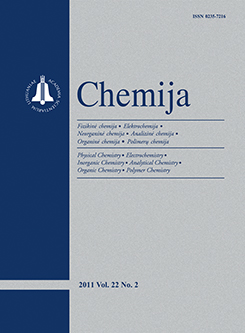Chemija / Chemistry
 ISSN 0235-7216 ISSN 2424-4538 (online) |
2013 m. Nr. 2 Chemical composition and chosen bioactive properties of Panax quinquefolius extracts
Panax quinquefolius L. (Araliaceae) is considered to be a medicine having potential to
prevent and treat various human diseases. This study determined the chemical composition (flavonoids, o-dihydroxyphenols – by the means of spectrophotometry and ginsenosides – by HPLC and HPLC-PDA/ESI/MS) of ethanol and hexane extracts of above- and underground parts of plants. Extracts obtained from roots and leaves of P. quinquefolius were also analyzed by GC-MS, and their antibacterial and antimutagenic activities were evaluated. The ginseng root ethanol and hexane extracts detected 55 and 32 volatile compounds, the leaf extracts revealed 45 and 33 compounds, respectively. The content of flavonoids and o-dihydroxyphenols in ginseng leaves was higher than in its roots, while a reverse tendency was observed in the content of ginsenosides. Ginsenosides Rb1 and Re were the main compounds of American ginseng roots, whereas ginsenosides Rb2, Rd and Re were the main ones in leaves. It was found that extracts tested were characterized by their antibacterial action. The strongest action on Gram-positive bacteria was shown by ethanol and hexane extracts of P. quinquefolius roots, while the other extracts had a weak effect. Hexane extracts of P. quinquefolius roots also showed strong antimutagenic activity (at the concentration of 1.0 mg/ml) – with S. typhimurium TA 1535 from the collection of the ATCC and sodium azide as a mutagen. Keywords: American ginseng, content of active substances, antibacterial activity, antimutagenic activity |
Issues:
2017 - Vol.28 No. 1, No. 2, No. 3, No. 4 2016 - Vol.27 No. 1, No. 2, No. 3, No. 4 2015 - Vol.26 No. 1, No. 2, No. 3, No. 4 2014 - Vol.25 No. 1, No. 2, No. 3, No. 4 2013 - Vol.24 No. 1, No. 2, No. 3, No. 4 2012 - Vol.23 No. 1, No. 2, No. 3, No. 4 2011 - Vol.22 No. 1, No. 2, No. 3, No. 4 2010 - Vol.21 No. 1, No. 2-4 2009 - Vol.20 No. 1, No. 2, No. 3, No. 4 2008 - Vol.19 No. 1, No. 2, No. 3-4 2007 - Vol.18 No. 1, No. 2, No. 3, No. 4 2006 - Vol.17 No. 1, No. 2-3, No. 4 2005 - Vol.16 No. 1, No. 2, No. 3-4 2004 - Vol.15 No. 1, No. 2, No. 3, No. 4 2003 - Vol.14 No. 1, No. 2, No. 3, No. 4 2002 - Vol.13 No. 1, No. 2, No. 3, No. 4 2001 - Vol.12 No. 1, No. 2, No. 3, No. 4 |